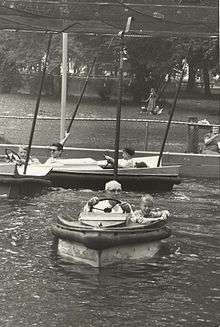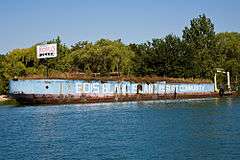Boblo Island Amusement Park
|
Former main dock to Boblo Island | |
| Coordinates | 42°05′38.19″N 83°07′2.94″W / 42.0939417°N 83.1174833°WCoordinates: 42°05′38.19″N 83°07′2.94″W / 42.0939417°N 83.1174833°W |
|---|---|
| Opened | 1898 |
| Closed | September 30, 1993 |
Boblo Island Amusement Park was an amusement park which ran from 1898 until its closure on September 30, 1993. Its amusement rides were sold in 1994.[1]
The park was located on Bois Blanc Island, Ontario. It lies just above the mouth of the Detroit River. The people of Detroit, Michigan characterized it as that city's Coney Island.[2]
Bob-Lo Boats
The island is a five-minute ferry ride from Amherstburg, Ontario, and 18 miles from Detroit. For more than 85 years, the park was serviced by the SS Ste. Clair and the SS Columbia excursion boats.[1] The Boblo Island Amusement Park was famous for those two steamers, the "Bob-Lo Boats," which went between Detroit and the island. They could hold about 2,500 passengers each.[1] The excursion boats were sold in November 1991.[1] Other smaller ferries served the park from Amherstburg and Gibraltar, Michigan, which were located closer to the park on the Detroit River.
Attractions
.jpg)
The Nightmare, Falling Star, Wild Mouse, Sky Streak, and Screamer rides, a Ferris wheel, a zoo, and a carousel were the signature attractions.[1] To move visitors around the island, the park constructed a small railroad.[1] Henry Ford financed a dance hall that was rumored to have been designed and built by famed Detroit architect Albert Kahn[3] but was later determined to have been designed by John Scott.[4] The dance hall was the second largest in the world, holding 5,000 dancers at full capacity[3] and featured one of the world's largest orchestrions from the Welte company: a 16 foot tall, 14 foot wide, self-playing orchestra with 419 pipes and percussion section.[4]

Boblo's Scootaboats, which were very similar to well known Bumper Cars, were a popular ride. These operated by drawing power from an overhead electric grid unlike Bumper Boats in use today.
Bob-Lo Excursion Co. v. Michigan
The State of Michigan brought a racial discrimination case, Bob-Lo Excursion Co. v. Michigan, against the operators of the ferry service.[2] The case reached the U.S. Supreme Court and resulted in a notable 1948 decision construing the scope of the commerce clause. In June 1945, Sarah Elizabeth Ray and twelve other female workers involved in the war effort (and referred to as "girls" during the legal proceedings) took part in a sponsored trip to Boblo Island. Ray was removed from the boat because she was not white, enforced according to a Bob-Lo company policy "excluding so-called 'Zoot-suiters,' the rowdyish, the rough, and the boisterous, and it also adopted the policy of excluding colored."[2] The company had claimed it could exclude her because it was a private concern operating in another country and that neither Michigan nor any other state had authority to regulate commerce with Canada (a foreign country); the United States Supreme Court affirmed the Michigan Supreme Court, which had upheld the jurisdiction of the state's anti-discrimination provisions and found against the company.[2]
See also
| Wikimedia Commons has media related to Boblo Island Amusement Park. |
References
- 1 2 3 4 5 6 Boblo Island Timeline from the Detroit News Archived January 4, 2009, at the Wayback Machine.
- 1 2 3 4 Bob-Lo Excursion Co. v. Michigan
- 1 2 Boblo Island Dance Hall Story from the Detroit News Archived March 6, 2009, at the Wayback Machine.
- 1 2 Detroit Free Press: Former Boblo Island music machine may draw up to $2.5 million at auction
